Organisation and Behaviour Report: CAPCO vs. Rocket Software Analysis
VerifiedAdded on 2020/02/14
|17
|6278
|48
Report
AI Summary
This report provides a comprehensive analysis of organisational behaviour, examining the structures, cultures, and leadership styles of two companies, CAPCO and Rocket Software Inc. It contrasts different organisational structures, including horizontal, matrix, and tall hierarchical structures, and explores how these structures influence company culture and performance. The report delves into the factors affecting individual behaviour at work, such as leadership, abilities, job satisfaction, and organisational justice. It assesses the effectiveness of various leadership styles, including democratic and autocratic approaches, and discusses the influence of organisational theories on management practices. Furthermore, the report compares motivational theories, like Maslow's and Herzberg's, and analyzes the impact of leadership styles on employee motivation during periods of change. Finally, it examines the dynamics of group behaviour and the impact of technology on teamwork within organisations, providing a detailed overview of the key elements of organisational behaviour.
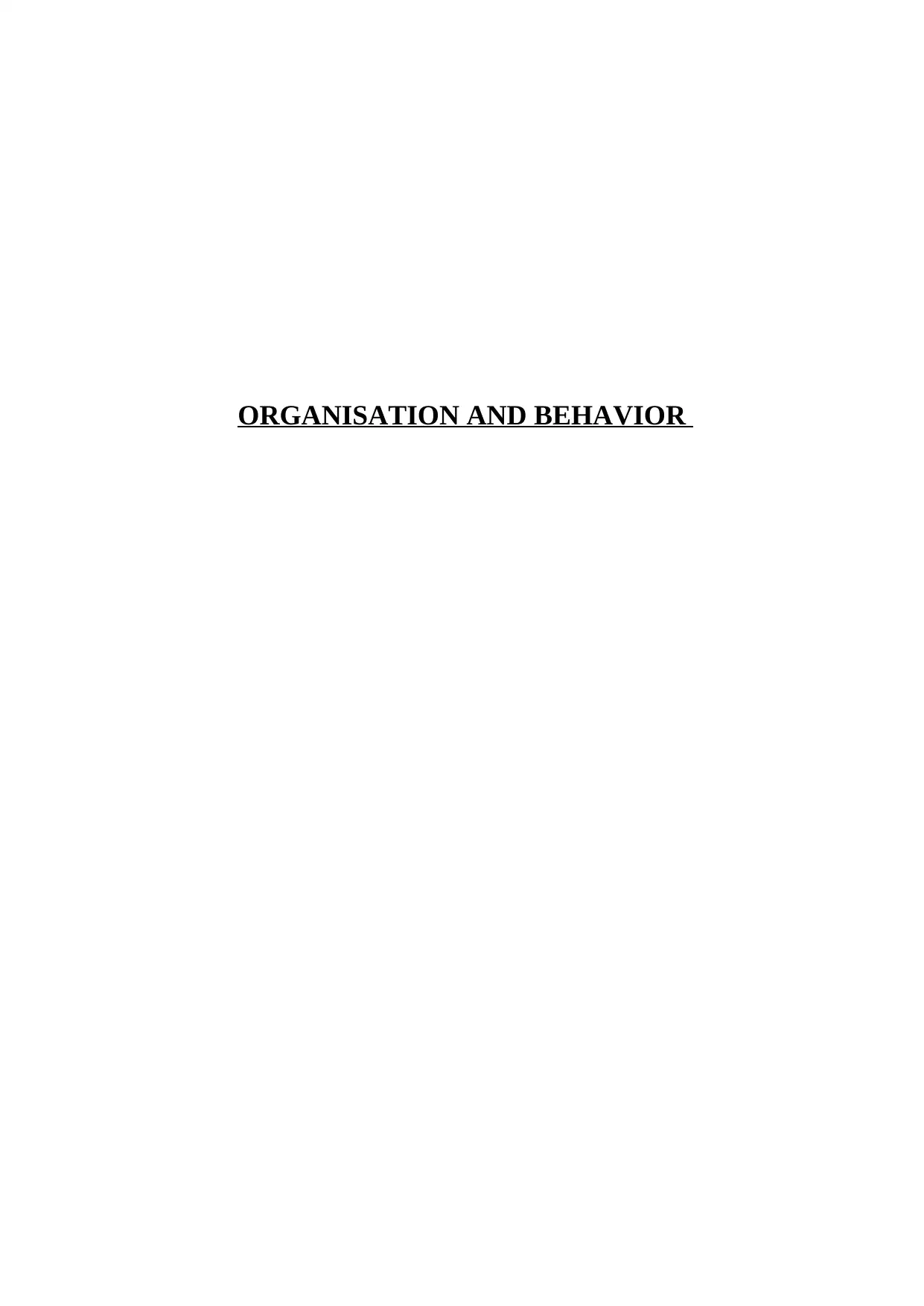
ORGANISATION AND BEHAVIOR
Paraphrase This Document
Need a fresh take? Get an instant paraphrase of this document with our AI Paraphraser
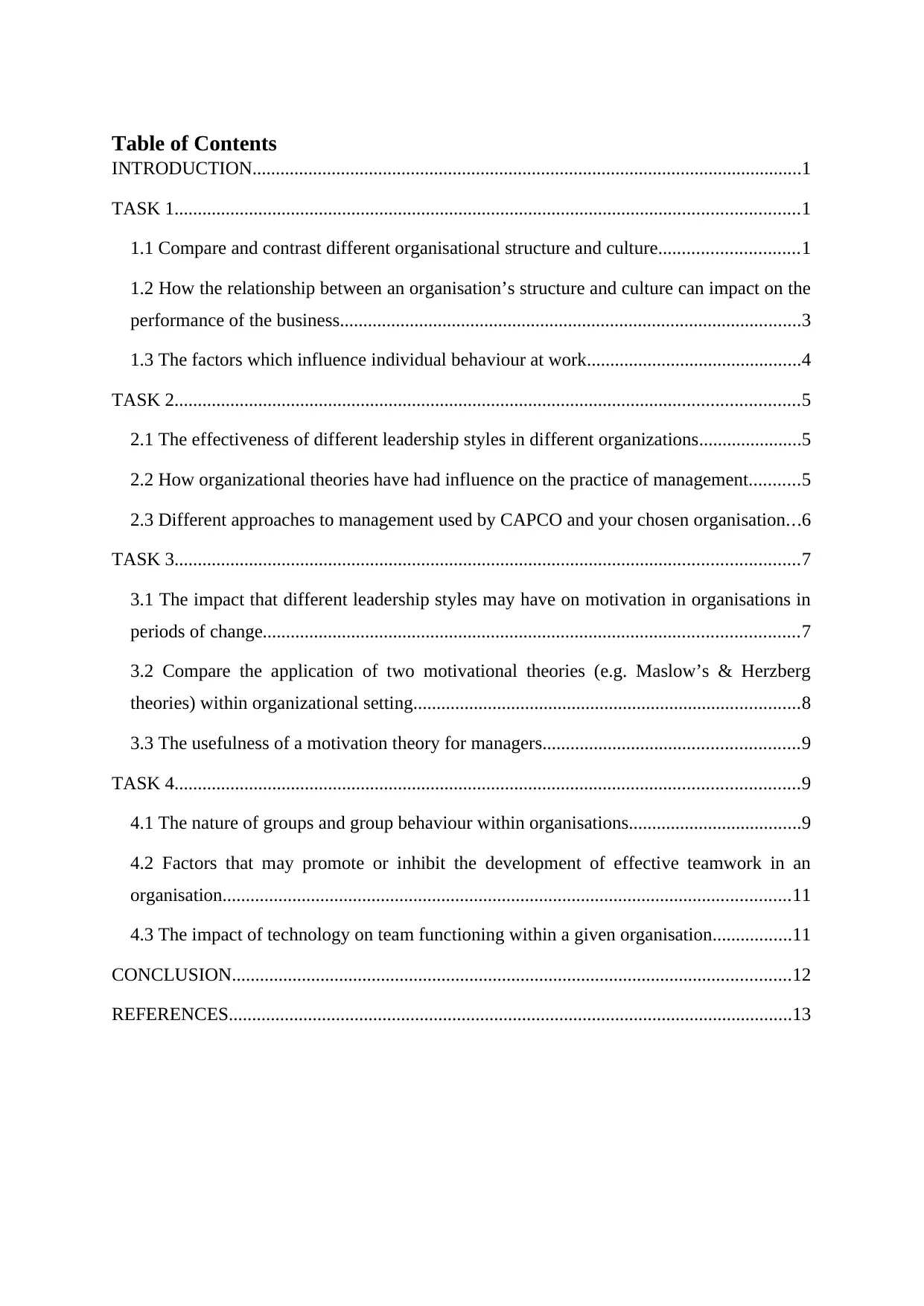
Table of Contents
INTRODUCTION......................................................................................................................1
TASK 1......................................................................................................................................1
1.1 Compare and contrast different organisational structure and culture..............................1
1.2 How the relationship between an organisation’s structure and culture can impact on the
performance of the business...................................................................................................3
1.3 The factors which influence individual behaviour at work..............................................4
TASK 2......................................................................................................................................5
2.1 The effectiveness of different leadership styles in different organizations......................5
2.2 How organizational theories have had influence on the practice of management...........5
2.3 Different approaches to management used by CAPCO and your chosen organisation...6
TASK 3......................................................................................................................................7
3.1 The impact that different leadership styles may have on motivation in organisations in
periods of change...................................................................................................................7
3.2 Compare the application of two motivational theories (e.g. Maslow’s & Herzberg
theories) within organizational setting...................................................................................8
3.3 The usefulness of a motivation theory for managers.......................................................9
TASK 4......................................................................................................................................9
4.1 The nature of groups and group behaviour within organisations.....................................9
4.2 Factors that may promote or inhibit the development of effective teamwork in an
organisation..........................................................................................................................11
4.3 The impact of technology on team functioning within a given organisation.................11
CONCLUSION........................................................................................................................12
REFERENCES.........................................................................................................................13
INTRODUCTION......................................................................................................................1
TASK 1......................................................................................................................................1
1.1 Compare and contrast different organisational structure and culture..............................1
1.2 How the relationship between an organisation’s structure and culture can impact on the
performance of the business...................................................................................................3
1.3 The factors which influence individual behaviour at work..............................................4
TASK 2......................................................................................................................................5
2.1 The effectiveness of different leadership styles in different organizations......................5
2.2 How organizational theories have had influence on the practice of management...........5
2.3 Different approaches to management used by CAPCO and your chosen organisation...6
TASK 3......................................................................................................................................7
3.1 The impact that different leadership styles may have on motivation in organisations in
periods of change...................................................................................................................7
3.2 Compare the application of two motivational theories (e.g. Maslow’s & Herzberg
theories) within organizational setting...................................................................................8
3.3 The usefulness of a motivation theory for managers.......................................................9
TASK 4......................................................................................................................................9
4.1 The nature of groups and group behaviour within organisations.....................................9
4.2 Factors that may promote or inhibit the development of effective teamwork in an
organisation..........................................................................................................................11
4.3 The impact of technology on team functioning within a given organisation.................11
CONCLUSION........................................................................................................................12
REFERENCES.........................................................................................................................13
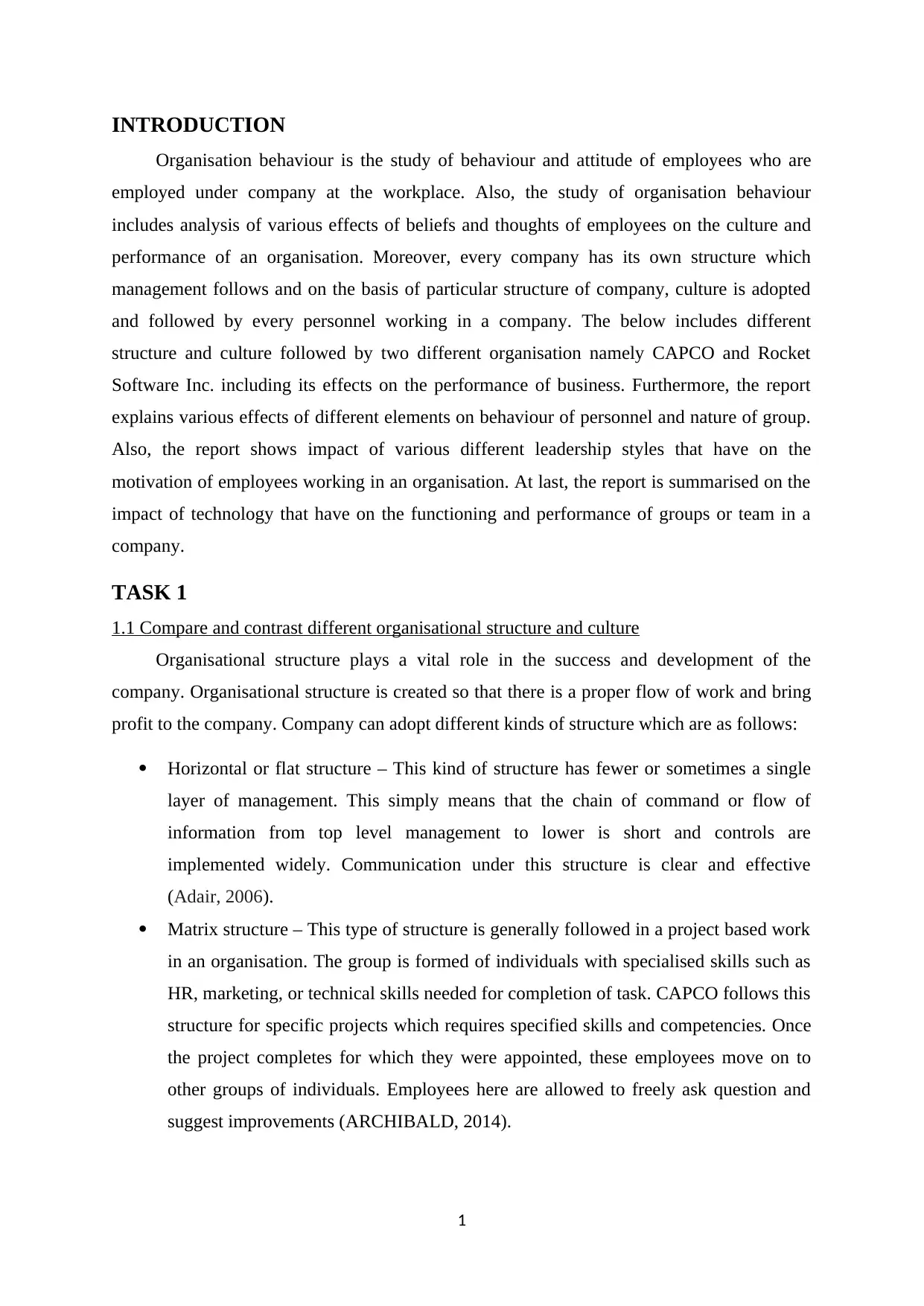
INTRODUCTION
Organisation behaviour is the study of behaviour and attitude of employees who are
employed under company at the workplace. Also, the study of organisation behaviour
includes analysis of various effects of beliefs and thoughts of employees on the culture and
performance of an organisation. Moreover, every company has its own structure which
management follows and on the basis of particular structure of company, culture is adopted
and followed by every personnel working in a company. The below includes different
structure and culture followed by two different organisation namely CAPCO and Rocket
Software Inc. including its effects on the performance of business. Furthermore, the report
explains various effects of different elements on behaviour of personnel and nature of group.
Also, the report shows impact of various different leadership styles that have on the
motivation of employees working in an organisation. At last, the report is summarised on the
impact of technology that have on the functioning and performance of groups or team in a
company.
TASK 1
1.1 Compare and contrast different organisational structure and culture
Organisational structure plays a vital role in the success and development of the
company. Organisational structure is created so that there is a proper flow of work and bring
profit to the company. Company can adopt different kinds of structure which are as follows:
Horizontal or flat structure – This kind of structure has fewer or sometimes a single
layer of management. This simply means that the chain of command or flow of
information from top level management to lower is short and controls are
implemented widely. Communication under this structure is clear and effective
(Adair, 2006).
Matrix structure – This type of structure is generally followed in a project based work
in an organisation. The group is formed of individuals with specialised skills such as
HR, marketing, or technical skills needed for completion of task. CAPCO follows this
structure for specific projects which requires specified skills and competencies. Once
the project completes for which they were appointed, these employees move on to
other groups of individuals. Employees here are allowed to freely ask question and
suggest improvements (ARCHIBALD, 2014).
1
Organisation behaviour is the study of behaviour and attitude of employees who are
employed under company at the workplace. Also, the study of organisation behaviour
includes analysis of various effects of beliefs and thoughts of employees on the culture and
performance of an organisation. Moreover, every company has its own structure which
management follows and on the basis of particular structure of company, culture is adopted
and followed by every personnel working in a company. The below includes different
structure and culture followed by two different organisation namely CAPCO and Rocket
Software Inc. including its effects on the performance of business. Furthermore, the report
explains various effects of different elements on behaviour of personnel and nature of group.
Also, the report shows impact of various different leadership styles that have on the
motivation of employees working in an organisation. At last, the report is summarised on the
impact of technology that have on the functioning and performance of groups or team in a
company.
TASK 1
1.1 Compare and contrast different organisational structure and culture
Organisational structure plays a vital role in the success and development of the
company. Organisational structure is created so that there is a proper flow of work and bring
profit to the company. Company can adopt different kinds of structure which are as follows:
Horizontal or flat structure – This kind of structure has fewer or sometimes a single
layer of management. This simply means that the chain of command or flow of
information from top level management to lower is short and controls are
implemented widely. Communication under this structure is clear and effective
(Adair, 2006).
Matrix structure – This type of structure is generally followed in a project based work
in an organisation. The group is formed of individuals with specialised skills such as
HR, marketing, or technical skills needed for completion of task. CAPCO follows this
structure for specific projects which requires specified skills and competencies. Once
the project completes for which they were appointed, these employees move on to
other groups of individuals. Employees here are allowed to freely ask question and
suggest improvements (ARCHIBALD, 2014).
1
⊘ This is a preview!⊘
Do you want full access?
Subscribe today to unlock all pages.

Trusted by 1+ million students worldwide
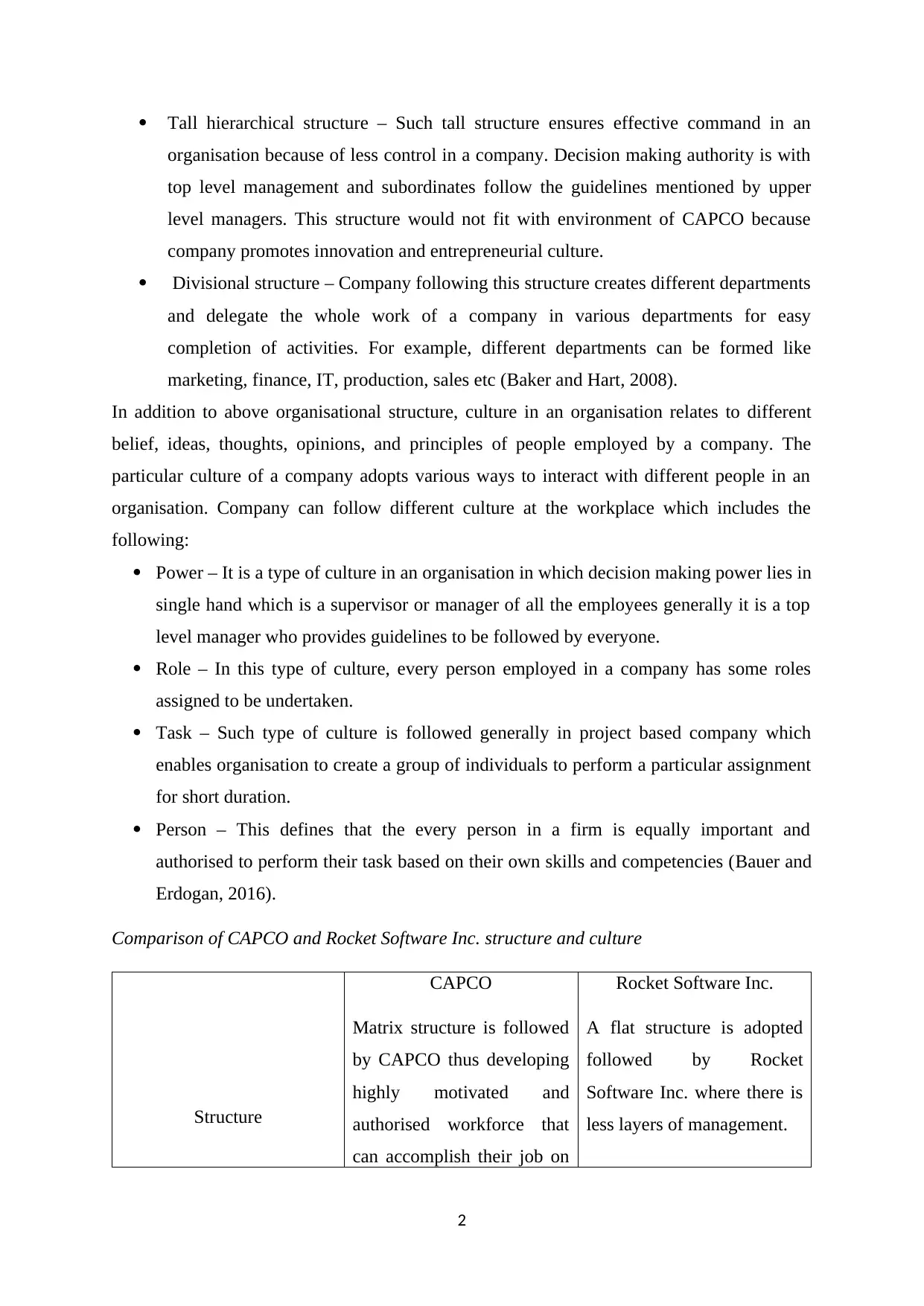
Tall hierarchical structure – Such tall structure ensures effective command in an
organisation because of less control in a company. Decision making authority is with
top level management and subordinates follow the guidelines mentioned by upper
level managers. This structure would not fit with environment of CAPCO because
company promotes innovation and entrepreneurial culture.
Divisional structure – Company following this structure creates different departments
and delegate the whole work of a company in various departments for easy
completion of activities. For example, different departments can be formed like
marketing, finance, IT, production, sales etc (Baker and Hart, 2008).
In addition to above organisational structure, culture in an organisation relates to different
belief, ideas, thoughts, opinions, and principles of people employed by a company. The
particular culture of a company adopts various ways to interact with different people in an
organisation. Company can follow different culture at the workplace which includes the
following:
Power – It is a type of culture in an organisation in which decision making power lies in
single hand which is a supervisor or manager of all the employees generally it is a top
level manager who provides guidelines to be followed by everyone.
Role – In this type of culture, every person employed in a company has some roles
assigned to be undertaken.
Task – Such type of culture is followed generally in project based company which
enables organisation to create a group of individuals to perform a particular assignment
for short duration.
Person – This defines that the every person in a firm is equally important and
authorised to perform their task based on their own skills and competencies (Bauer and
Erdogan, 2016).
Comparison of CAPCO and Rocket Software Inc. structure and culture
Structure
CAPCO
Matrix structure is followed
by CAPCO thus developing
highly motivated and
authorised workforce that
can accomplish their job on
Rocket Software Inc.
A flat structure is adopted
followed by Rocket
Software Inc. where there is
less layers of management.
2
organisation because of less control in a company. Decision making authority is with
top level management and subordinates follow the guidelines mentioned by upper
level managers. This structure would not fit with environment of CAPCO because
company promotes innovation and entrepreneurial culture.
Divisional structure – Company following this structure creates different departments
and delegate the whole work of a company in various departments for easy
completion of activities. For example, different departments can be formed like
marketing, finance, IT, production, sales etc (Baker and Hart, 2008).
In addition to above organisational structure, culture in an organisation relates to different
belief, ideas, thoughts, opinions, and principles of people employed by a company. The
particular culture of a company adopts various ways to interact with different people in an
organisation. Company can follow different culture at the workplace which includes the
following:
Power – It is a type of culture in an organisation in which decision making power lies in
single hand which is a supervisor or manager of all the employees generally it is a top
level manager who provides guidelines to be followed by everyone.
Role – In this type of culture, every person employed in a company has some roles
assigned to be undertaken.
Task – Such type of culture is followed generally in project based company which
enables organisation to create a group of individuals to perform a particular assignment
for short duration.
Person – This defines that the every person in a firm is equally important and
authorised to perform their task based on their own skills and competencies (Bauer and
Erdogan, 2016).
Comparison of CAPCO and Rocket Software Inc. structure and culture
Structure
CAPCO
Matrix structure is followed
by CAPCO thus developing
highly motivated and
authorised workforce that
can accomplish their job on
Rocket Software Inc.
A flat structure is adopted
followed by Rocket
Software Inc. where there is
less layers of management.
2
Paraphrase This Document
Need a fresh take? Get an instant paraphrase of this document with our AI Paraphraser
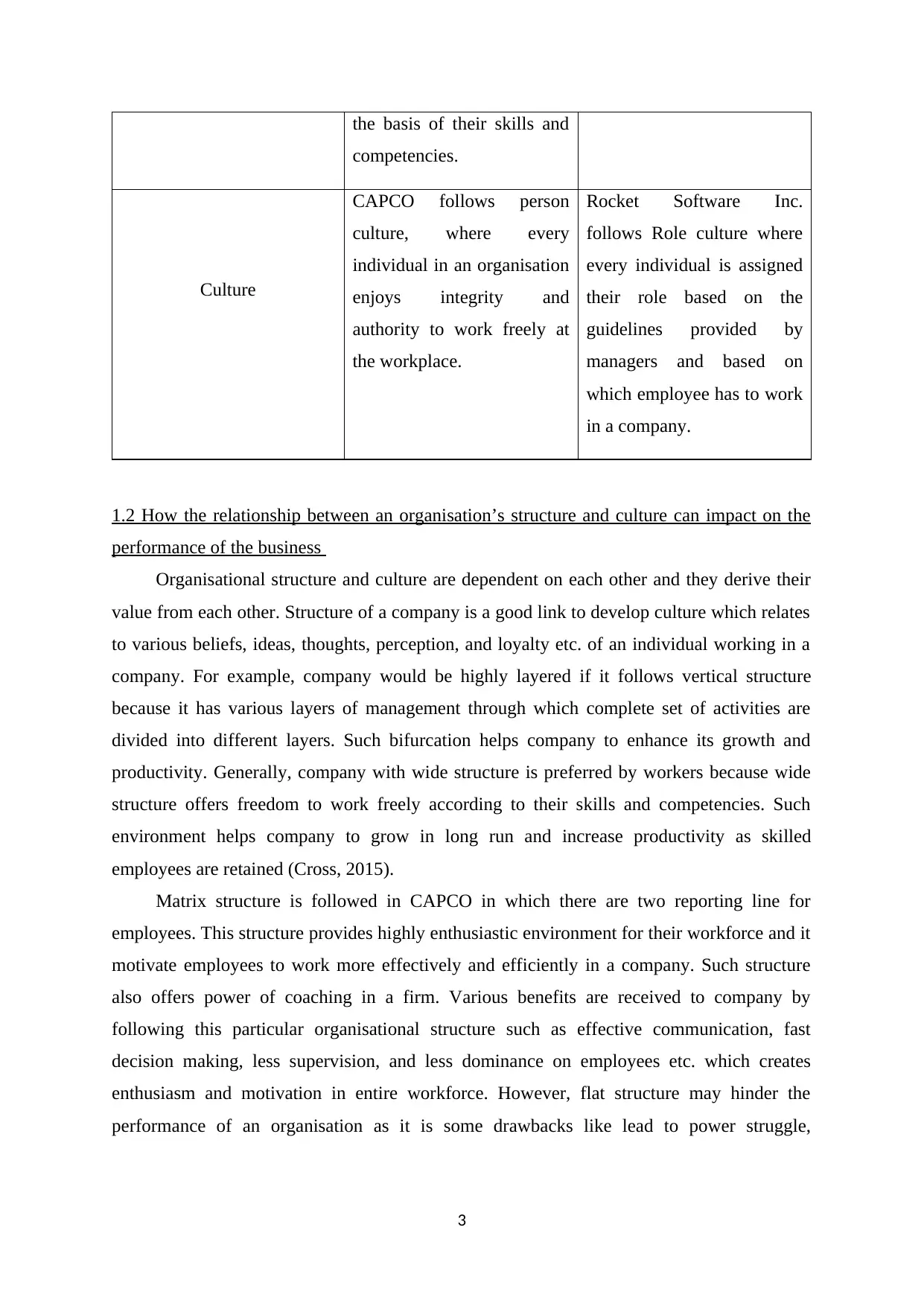
the basis of their skills and
competencies.
Culture
CAPCO follows person
culture, where every
individual in an organisation
enjoys integrity and
authority to work freely at
the workplace.
Rocket Software Inc.
follows Role culture where
every individual is assigned
their role based on the
guidelines provided by
managers and based on
which employee has to work
in a company.
1.2 How the relationship between an organisation’s structure and culture can impact on the
performance of the business
Organisational structure and culture are dependent on each other and they derive their
value from each other. Structure of a company is a good link to develop culture which relates
to various beliefs, ideas, thoughts, perception, and loyalty etc. of an individual working in a
company. For example, company would be highly layered if it follows vertical structure
because it has various layers of management through which complete set of activities are
divided into different layers. Such bifurcation helps company to enhance its growth and
productivity. Generally, company with wide structure is preferred by workers because wide
structure offers freedom to work freely according to their skills and competencies. Such
environment helps company to grow in long run and increase productivity as skilled
employees are retained (Cross, 2015).
Matrix structure is followed in CAPCO in which there are two reporting line for
employees. This structure provides highly enthusiastic environment for their workforce and it
motivate employees to work more effectively and efficiently in a company. Such structure
also offers power of coaching in a firm. Various benefits are received to company by
following this particular organisational structure such as effective communication, fast
decision making, less supervision, and less dominance on employees etc. which creates
enthusiasm and motivation in entire workforce. However, flat structure may hinder the
performance of an organisation as it is some drawbacks like lead to power struggle,
3
competencies.
Culture
CAPCO follows person
culture, where every
individual in an organisation
enjoys integrity and
authority to work freely at
the workplace.
Rocket Software Inc.
follows Role culture where
every individual is assigned
their role based on the
guidelines provided by
managers and based on
which employee has to work
in a company.
1.2 How the relationship between an organisation’s structure and culture can impact on the
performance of the business
Organisational structure and culture are dependent on each other and they derive their
value from each other. Structure of a company is a good link to develop culture which relates
to various beliefs, ideas, thoughts, perception, and loyalty etc. of an individual working in a
company. For example, company would be highly layered if it follows vertical structure
because it has various layers of management through which complete set of activities are
divided into different layers. Such bifurcation helps company to enhance its growth and
productivity. Generally, company with wide structure is preferred by workers because wide
structure offers freedom to work freely according to their skills and competencies. Such
environment helps company to grow in long run and increase productivity as skilled
employees are retained (Cross, 2015).
Matrix structure is followed in CAPCO in which there are two reporting line for
employees. This structure provides highly enthusiastic environment for their workforce and it
motivate employees to work more effectively and efficiently in a company. Such structure
also offers power of coaching in a firm. Various benefits are received to company by
following this particular organisational structure such as effective communication, fast
decision making, less supervision, and less dominance on employees etc. which creates
enthusiasm and motivation in entire workforce. However, flat structure may hinder the
performance of an organisation as it is some drawbacks like lead to power struggle,
3
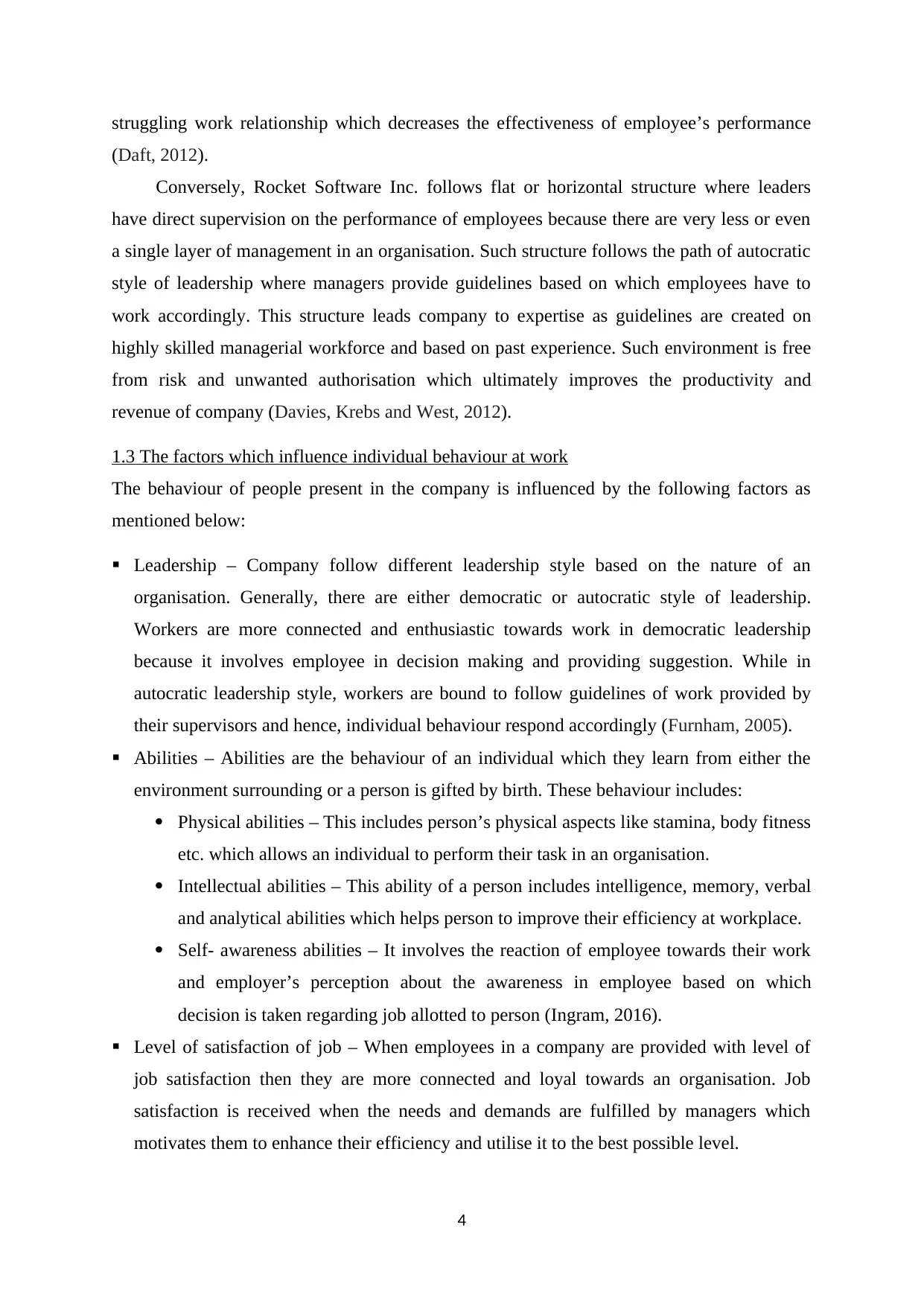
struggling work relationship which decreases the effectiveness of employee’s performance
(Daft, 2012).
Conversely, Rocket Software Inc. follows flat or horizontal structure where leaders
have direct supervision on the performance of employees because there are very less or even
a single layer of management in an organisation. Such structure follows the path of autocratic
style of leadership where managers provide guidelines based on which employees have to
work accordingly. This structure leads company to expertise as guidelines are created on
highly skilled managerial workforce and based on past experience. Such environment is free
from risk and unwanted authorisation which ultimately improves the productivity and
revenue of company (Davies, Krebs and West, 2012).
1.3 The factors which influence individual behaviour at work
The behaviour of people present in the company is influenced by the following factors as
mentioned below:
Leadership – Company follow different leadership style based on the nature of an
organisation. Generally, there are either democratic or autocratic style of leadership.
Workers are more connected and enthusiastic towards work in democratic leadership
because it involves employee in decision making and providing suggestion. While in
autocratic leadership style, workers are bound to follow guidelines of work provided by
their supervisors and hence, individual behaviour respond accordingly (Furnham, 2005).
Abilities – Abilities are the behaviour of an individual which they learn from either the
environment surrounding or a person is gifted by birth. These behaviour includes:
Physical abilities – This includes person’s physical aspects like stamina, body fitness
etc. which allows an individual to perform their task in an organisation.
Intellectual abilities – This ability of a person includes intelligence, memory, verbal
and analytical abilities which helps person to improve their efficiency at workplace.
Self- awareness abilities – It involves the reaction of employee towards their work
and employer’s perception about the awareness in employee based on which
decision is taken regarding job allotted to person (Ingram, 2016).
Level of satisfaction of job – When employees in a company are provided with level of
job satisfaction then they are more connected and loyal towards an organisation. Job
satisfaction is received when the needs and demands are fulfilled by managers which
motivates them to enhance their efficiency and utilise it to the best possible level.
4
(Daft, 2012).
Conversely, Rocket Software Inc. follows flat or horizontal structure where leaders
have direct supervision on the performance of employees because there are very less or even
a single layer of management in an organisation. Such structure follows the path of autocratic
style of leadership where managers provide guidelines based on which employees have to
work accordingly. This structure leads company to expertise as guidelines are created on
highly skilled managerial workforce and based on past experience. Such environment is free
from risk and unwanted authorisation which ultimately improves the productivity and
revenue of company (Davies, Krebs and West, 2012).
1.3 The factors which influence individual behaviour at work
The behaviour of people present in the company is influenced by the following factors as
mentioned below:
Leadership – Company follow different leadership style based on the nature of an
organisation. Generally, there are either democratic or autocratic style of leadership.
Workers are more connected and enthusiastic towards work in democratic leadership
because it involves employee in decision making and providing suggestion. While in
autocratic leadership style, workers are bound to follow guidelines of work provided by
their supervisors and hence, individual behaviour respond accordingly (Furnham, 2005).
Abilities – Abilities are the behaviour of an individual which they learn from either the
environment surrounding or a person is gifted by birth. These behaviour includes:
Physical abilities – This includes person’s physical aspects like stamina, body fitness
etc. which allows an individual to perform their task in an organisation.
Intellectual abilities – This ability of a person includes intelligence, memory, verbal
and analytical abilities which helps person to improve their efficiency at workplace.
Self- awareness abilities – It involves the reaction of employee towards their work
and employer’s perception about the awareness in employee based on which
decision is taken regarding job allotted to person (Ingram, 2016).
Level of satisfaction of job – When employees in a company are provided with level of
job satisfaction then they are more connected and loyal towards an organisation. Job
satisfaction is received when the needs and demands are fulfilled by managers which
motivates them to enhance their efficiency and utilise it to the best possible level.
4
⊘ This is a preview!⊘
Do you want full access?
Subscribe today to unlock all pages.

Trusted by 1+ million students worldwide
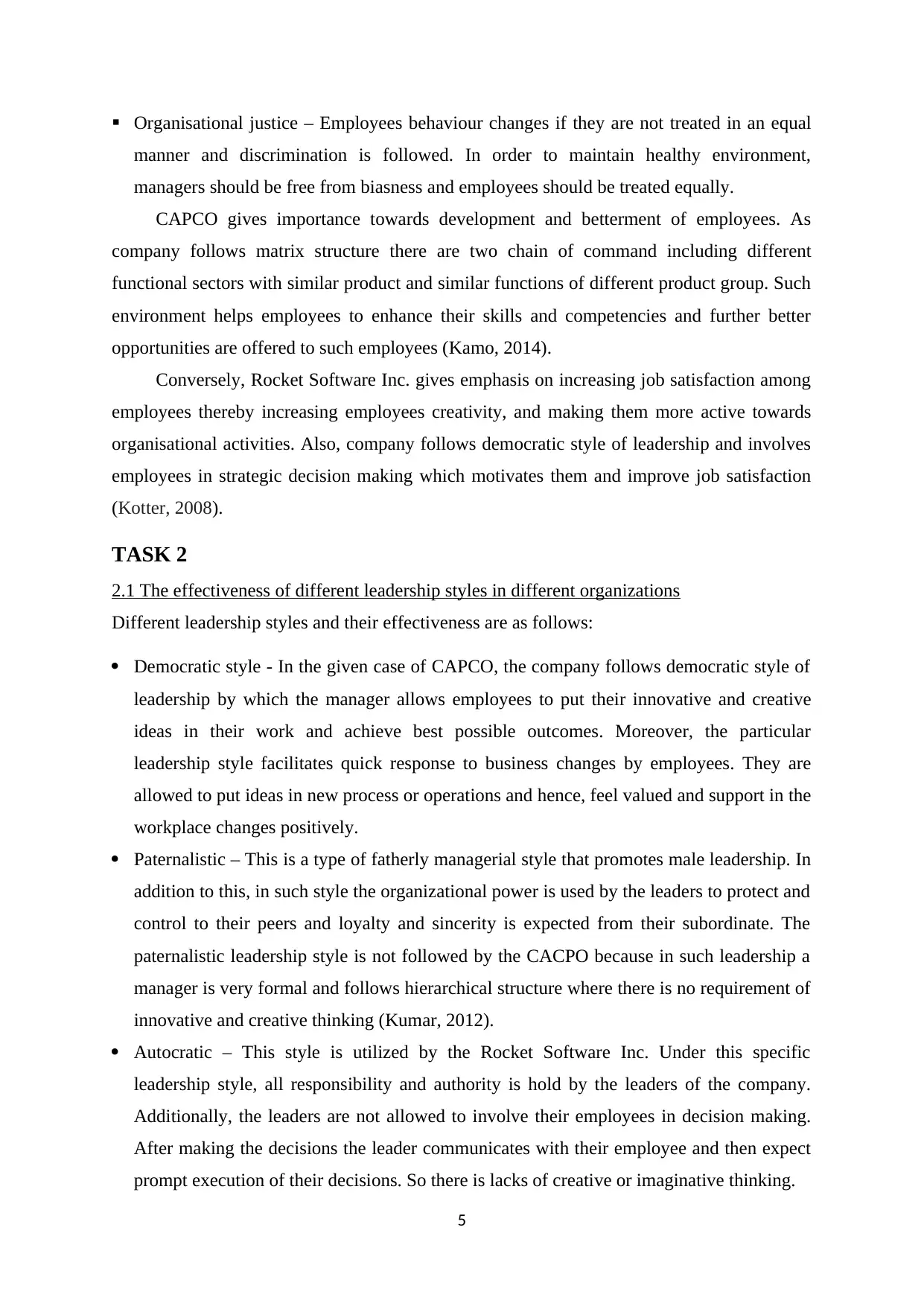
Organisational justice – Employees behaviour changes if they are not treated in an equal
manner and discrimination is followed. In order to maintain healthy environment,
managers should be free from biasness and employees should be treated equally.
CAPCO gives importance towards development and betterment of employees. As
company follows matrix structure there are two chain of command including different
functional sectors with similar product and similar functions of different product group. Such
environment helps employees to enhance their skills and competencies and further better
opportunities are offered to such employees (Kamo, 2014).
Conversely, Rocket Software Inc. gives emphasis on increasing job satisfaction among
employees thereby increasing employees creativity, and making them more active towards
organisational activities. Also, company follows democratic style of leadership and involves
employees in strategic decision making which motivates them and improve job satisfaction
(Kotter, 2008).
TASK 2
2.1 The effectiveness of different leadership styles in different organizations
Different leadership styles and their effectiveness are as follows:
Democratic style - In the given case of CAPCO, the company follows democratic style of
leadership by which the manager allows employees to put their innovative and creative
ideas in their work and achieve best possible outcomes. Moreover, the particular
leadership style facilitates quick response to business changes by employees. They are
allowed to put ideas in new process or operations and hence, feel valued and support in the
workplace changes positively.
Paternalistic – This is a type of fatherly managerial style that promotes male leadership. In
addition to this, in such style the organizational power is used by the leaders to protect and
control to their peers and loyalty and sincerity is expected from their subordinate. The
paternalistic leadership style is not followed by the CACPO because in such leadership a
manager is very formal and follows hierarchical structure where there is no requirement of
innovative and creative thinking (Kumar, 2012).
Autocratic – This style is utilized by the Rocket Software Inc. Under this specific
leadership style, all responsibility and authority is hold by the leaders of the company.
Additionally, the leaders are not allowed to involve their employees in decision making.
After making the decisions the leader communicates with their employee and then expect
prompt execution of their decisions. So there is lacks of creative or imaginative thinking.
5
manner and discrimination is followed. In order to maintain healthy environment,
managers should be free from biasness and employees should be treated equally.
CAPCO gives importance towards development and betterment of employees. As
company follows matrix structure there are two chain of command including different
functional sectors with similar product and similar functions of different product group. Such
environment helps employees to enhance their skills and competencies and further better
opportunities are offered to such employees (Kamo, 2014).
Conversely, Rocket Software Inc. gives emphasis on increasing job satisfaction among
employees thereby increasing employees creativity, and making them more active towards
organisational activities. Also, company follows democratic style of leadership and involves
employees in strategic decision making which motivates them and improve job satisfaction
(Kotter, 2008).
TASK 2
2.1 The effectiveness of different leadership styles in different organizations
Different leadership styles and their effectiveness are as follows:
Democratic style - In the given case of CAPCO, the company follows democratic style of
leadership by which the manager allows employees to put their innovative and creative
ideas in their work and achieve best possible outcomes. Moreover, the particular
leadership style facilitates quick response to business changes by employees. They are
allowed to put ideas in new process or operations and hence, feel valued and support in the
workplace changes positively.
Paternalistic – This is a type of fatherly managerial style that promotes male leadership. In
addition to this, in such style the organizational power is used by the leaders to protect and
control to their peers and loyalty and sincerity is expected from their subordinate. The
paternalistic leadership style is not followed by the CACPO because in such leadership a
manager is very formal and follows hierarchical structure where there is no requirement of
innovative and creative thinking (Kumar, 2012).
Autocratic – This style is utilized by the Rocket Software Inc. Under this specific
leadership style, all responsibility and authority is hold by the leaders of the company.
Additionally, the leaders are not allowed to involve their employees in decision making.
After making the decisions the leader communicates with their employee and then expect
prompt execution of their decisions. So there is lacks of creative or imaginative thinking.
5
Paraphrase This Document
Need a fresh take? Get an instant paraphrase of this document with our AI Paraphraser
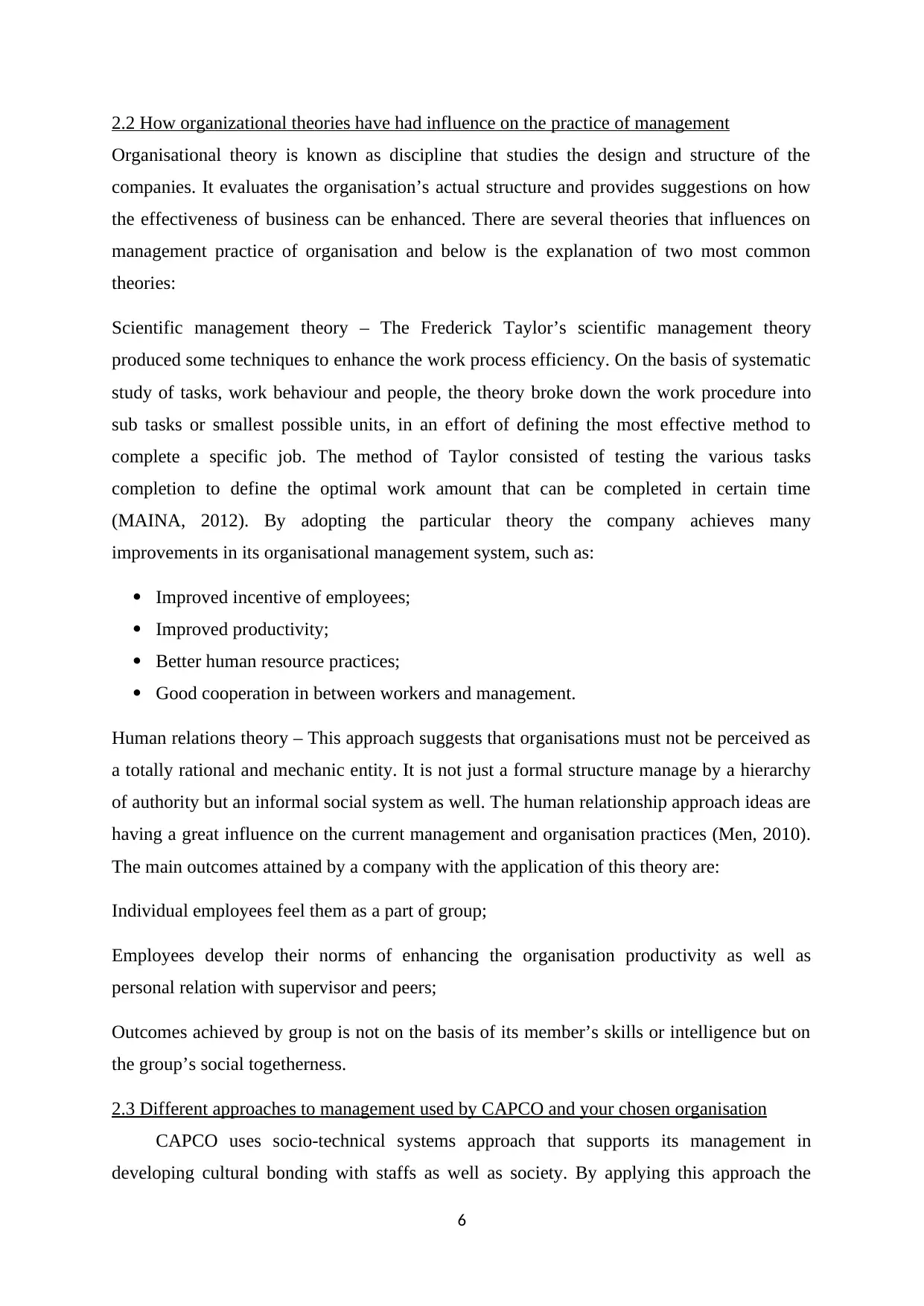
2.2 How organizational theories have had influence on the practice of management
Organisational theory is known as discipline that studies the design and structure of the
companies. It evaluates the organisation’s actual structure and provides suggestions on how
the effectiveness of business can be enhanced. There are several theories that influences on
management practice of organisation and below is the explanation of two most common
theories:
Scientific management theory – The Frederick Taylor’s scientific management theory
produced some techniques to enhance the work process efficiency. On the basis of systematic
study of tasks, work behaviour and people, the theory broke down the work procedure into
sub tasks or smallest possible units, in an effort of defining the most effective method to
complete a specific job. The method of Taylor consisted of testing the various tasks
completion to define the optimal work amount that can be completed in certain time
(MAINA, 2012). By adopting the particular theory the company achieves many
improvements in its organisational management system, such as:
Improved incentive of employees;
Improved productivity;
Better human resource practices;
Good cooperation in between workers and management.
Human relations theory – This approach suggests that organisations must not be perceived as
a totally rational and mechanic entity. It is not just a formal structure manage by a hierarchy
of authority but an informal social system as well. The human relationship approach ideas are
having a great influence on the current management and organisation practices (Men, 2010).
The main outcomes attained by a company with the application of this theory are:
Individual employees feel them as a part of group;
Employees develop their norms of enhancing the organisation productivity as well as
personal relation with supervisor and peers;
Outcomes achieved by group is not on the basis of its member’s skills or intelligence but on
the group’s social togetherness.
2.3 Different approaches to management used by CAPCO and your chosen organisation
CAPCO uses socio-technical systems approach that supports its management in
developing cultural bonding with staffs as well as society. By applying this approach the
6
Organisational theory is known as discipline that studies the design and structure of the
companies. It evaluates the organisation’s actual structure and provides suggestions on how
the effectiveness of business can be enhanced. There are several theories that influences on
management practice of organisation and below is the explanation of two most common
theories:
Scientific management theory – The Frederick Taylor’s scientific management theory
produced some techniques to enhance the work process efficiency. On the basis of systematic
study of tasks, work behaviour and people, the theory broke down the work procedure into
sub tasks or smallest possible units, in an effort of defining the most effective method to
complete a specific job. The method of Taylor consisted of testing the various tasks
completion to define the optimal work amount that can be completed in certain time
(MAINA, 2012). By adopting the particular theory the company achieves many
improvements in its organisational management system, such as:
Improved incentive of employees;
Improved productivity;
Better human resource practices;
Good cooperation in between workers and management.
Human relations theory – This approach suggests that organisations must not be perceived as
a totally rational and mechanic entity. It is not just a formal structure manage by a hierarchy
of authority but an informal social system as well. The human relationship approach ideas are
having a great influence on the current management and organisation practices (Men, 2010).
The main outcomes attained by a company with the application of this theory are:
Individual employees feel them as a part of group;
Employees develop their norms of enhancing the organisation productivity as well as
personal relation with supervisor and peers;
Outcomes achieved by group is not on the basis of its member’s skills or intelligence but on
the group’s social togetherness.
2.3 Different approaches to management used by CAPCO and your chosen organisation
CAPCO uses socio-technical systems approach that supports its management in
developing cultural bonding with staffs as well as society. By applying this approach the
6
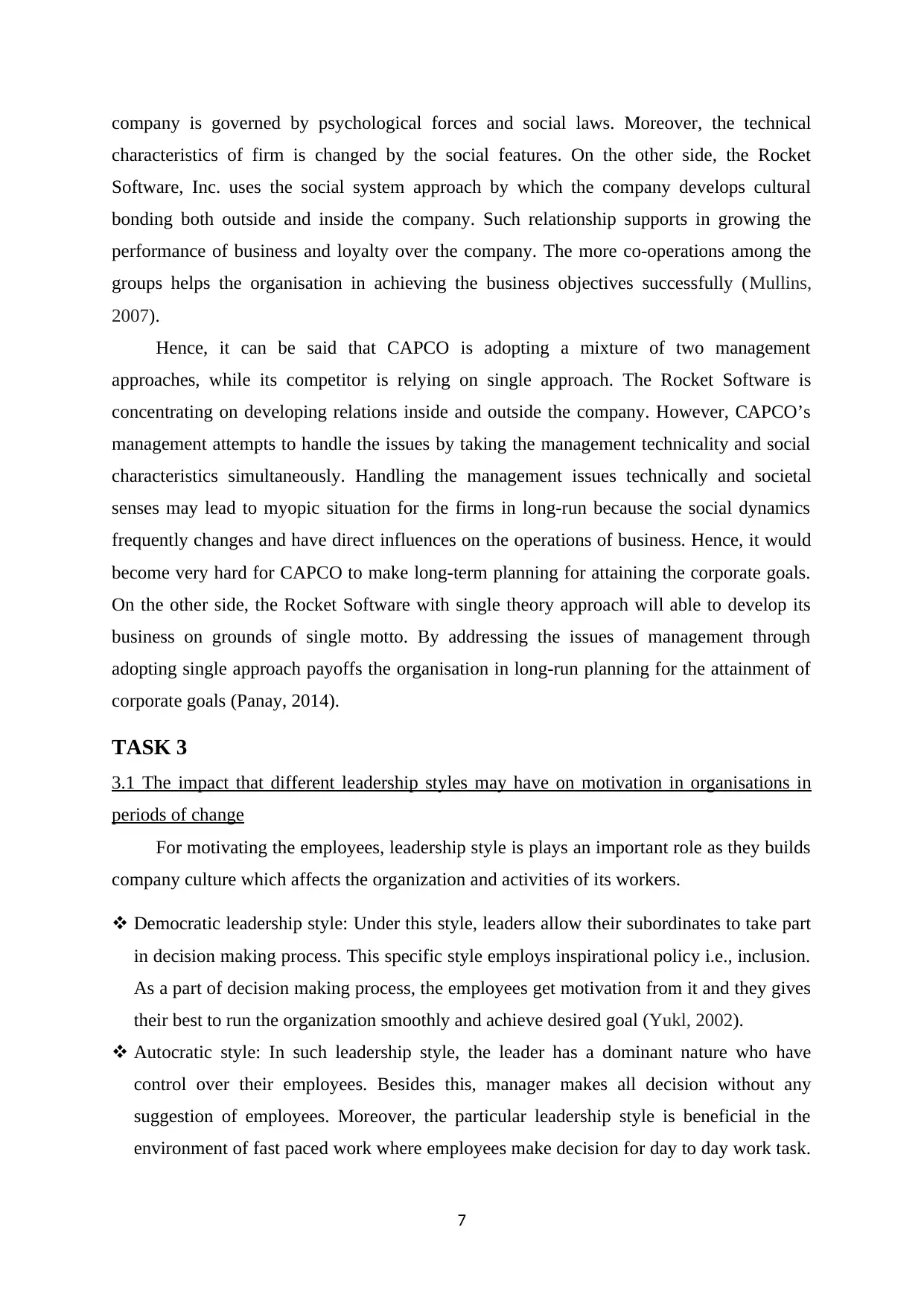
company is governed by psychological forces and social laws. Moreover, the technical
characteristics of firm is changed by the social features. On the other side, the Rocket
Software, Inc. uses the social system approach by which the company develops cultural
bonding both outside and inside the company. Such relationship supports in growing the
performance of business and loyalty over the company. The more co-operations among the
groups helps the organisation in achieving the business objectives successfully (Mullins,
2007).
Hence, it can be said that CAPCO is adopting a mixture of two management
approaches, while its competitor is relying on single approach. The Rocket Software is
concentrating on developing relations inside and outside the company. However, CAPCO’s
management attempts to handle the issues by taking the management technicality and social
characteristics simultaneously. Handling the management issues technically and societal
senses may lead to myopic situation for the firms in long-run because the social dynamics
frequently changes and have direct influences on the operations of business. Hence, it would
become very hard for CAPCO to make long-term planning for attaining the corporate goals.
On the other side, the Rocket Software with single theory approach will able to develop its
business on grounds of single motto. By addressing the issues of management through
adopting single approach payoffs the organisation in long-run planning for the attainment of
corporate goals (Panay, 2014).
TASK 3
3.1 The impact that different leadership styles may have on motivation in organisations in
periods of change
For motivating the employees, leadership style is plays an important role as they builds
company culture which affects the organization and activities of its workers.
Democratic leadership style: Under this style, leaders allow their subordinates to take part
in decision making process. This specific style employs inspirational policy i.e., inclusion.
As a part of decision making process, the employees get motivation from it and they gives
their best to run the organization smoothly and achieve desired goal (Yukl, 2002).
Autocratic style: In such leadership style, the leader has a dominant nature who have
control over their employees. Besides this, manager makes all decision without any
suggestion of employees. Moreover, the particular leadership style is beneficial in the
environment of fast paced work where employees make decision for day to day work task.
7
characteristics of firm is changed by the social features. On the other side, the Rocket
Software, Inc. uses the social system approach by which the company develops cultural
bonding both outside and inside the company. Such relationship supports in growing the
performance of business and loyalty over the company. The more co-operations among the
groups helps the organisation in achieving the business objectives successfully (Mullins,
2007).
Hence, it can be said that CAPCO is adopting a mixture of two management
approaches, while its competitor is relying on single approach. The Rocket Software is
concentrating on developing relations inside and outside the company. However, CAPCO’s
management attempts to handle the issues by taking the management technicality and social
characteristics simultaneously. Handling the management issues technically and societal
senses may lead to myopic situation for the firms in long-run because the social dynamics
frequently changes and have direct influences on the operations of business. Hence, it would
become very hard for CAPCO to make long-term planning for attaining the corporate goals.
On the other side, the Rocket Software with single theory approach will able to develop its
business on grounds of single motto. By addressing the issues of management through
adopting single approach payoffs the organisation in long-run planning for the attainment of
corporate goals (Panay, 2014).
TASK 3
3.1 The impact that different leadership styles may have on motivation in organisations in
periods of change
For motivating the employees, leadership style is plays an important role as they builds
company culture which affects the organization and activities of its workers.
Democratic leadership style: Under this style, leaders allow their subordinates to take part
in decision making process. This specific style employs inspirational policy i.e., inclusion.
As a part of decision making process, the employees get motivation from it and they gives
their best to run the organization smoothly and achieve desired goal (Yukl, 2002).
Autocratic style: In such leadership style, the leader has a dominant nature who have
control over their employees. Besides this, manager makes all decision without any
suggestion of employees. Moreover, the particular leadership style is beneficial in the
environment of fast paced work where employees make decision for day to day work task.
7
⊘ This is a preview!⊘
Do you want full access?
Subscribe today to unlock all pages.

Trusted by 1+ million students worldwide
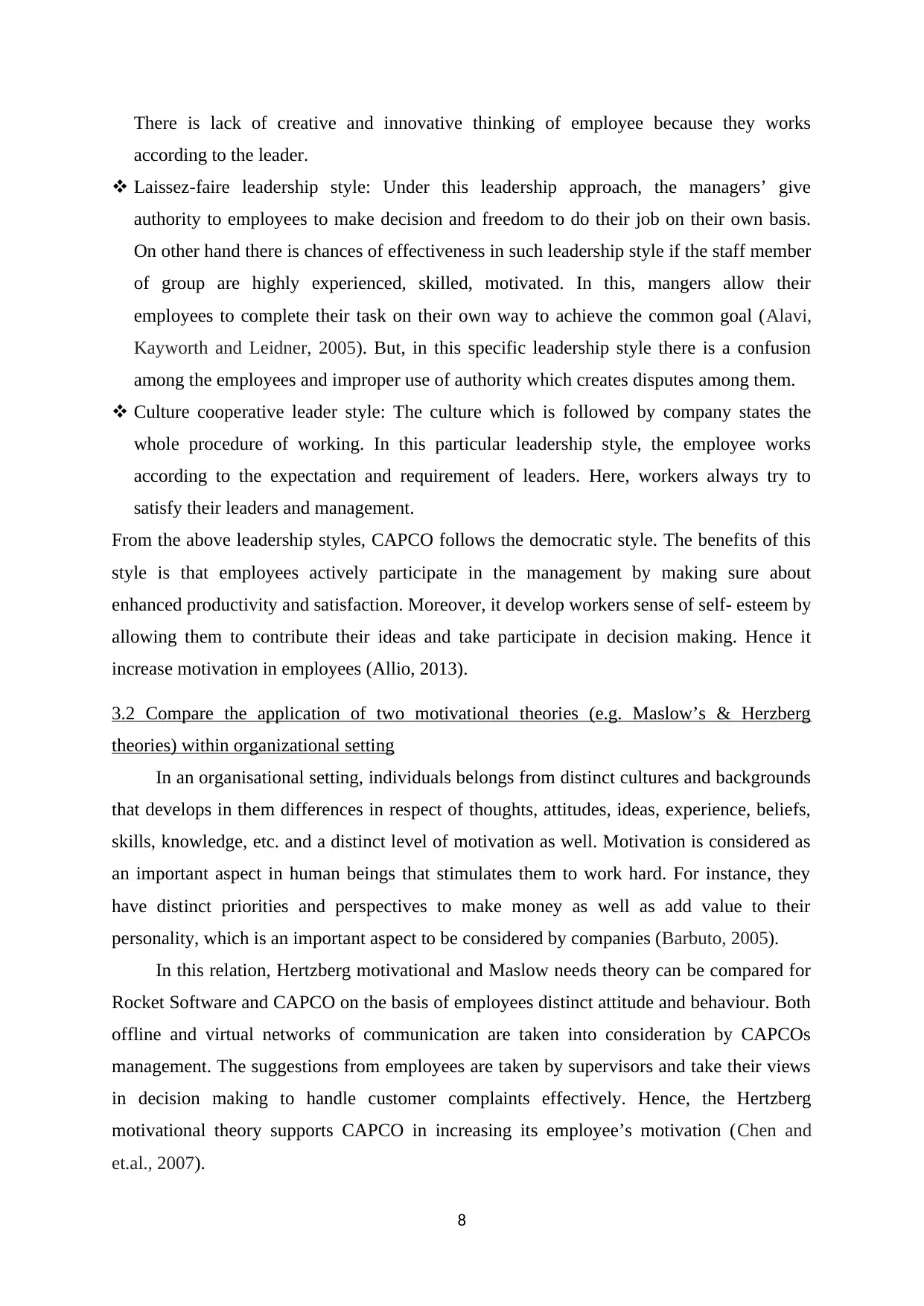
There is lack of creative and innovative thinking of employee because they works
according to the leader.
Laissez-faire leadership style: Under this leadership approach, the managers’ give
authority to employees to make decision and freedom to do their job on their own basis.
On other hand there is chances of effectiveness in such leadership style if the staff member
of group are highly experienced, skilled, motivated. In this, mangers allow their
employees to complete their task on their own way to achieve the common goal (Alavi,
Kayworth and Leidner, 2005). But, in this specific leadership style there is a confusion
among the employees and improper use of authority which creates disputes among them.
Culture cooperative leader style: The culture which is followed by company states the
whole procedure of working. In this particular leadership style, the employee works
according to the expectation and requirement of leaders. Here, workers always try to
satisfy their leaders and management.
From the above leadership styles, CAPCO follows the democratic style. The benefits of this
style is that employees actively participate in the management by making sure about
enhanced productivity and satisfaction. Moreover, it develop workers sense of self- esteem by
allowing them to contribute their ideas and take participate in decision making. Hence it
increase motivation in employees (Allio, 2013).
3.2 Compare the application of two motivational theories (e.g. Maslow’s & Herzberg
theories) within organizational setting
In an organisational setting, individuals belongs from distinct cultures and backgrounds
that develops in them differences in respect of thoughts, attitudes, ideas, experience, beliefs,
skills, knowledge, etc. and a distinct level of motivation as well. Motivation is considered as
an important aspect in human beings that stimulates them to work hard. For instance, they
have distinct priorities and perspectives to make money as well as add value to their
personality, which is an important aspect to be considered by companies (Barbuto, 2005).
In this relation, Hertzberg motivational and Maslow needs theory can be compared for
Rocket Software and CAPCO on the basis of employees distinct attitude and behaviour. Both
offline and virtual networks of communication are taken into consideration by CAPCOs
management. The suggestions from employees are taken by supervisors and take their views
in decision making to handle customer complaints effectively. Hence, the Hertzberg
motivational theory supports CAPCO in increasing its employee’s motivation (Chen and
et.al., 2007).
8
according to the leader.
Laissez-faire leadership style: Under this leadership approach, the managers’ give
authority to employees to make decision and freedom to do their job on their own basis.
On other hand there is chances of effectiveness in such leadership style if the staff member
of group are highly experienced, skilled, motivated. In this, mangers allow their
employees to complete their task on their own way to achieve the common goal (Alavi,
Kayworth and Leidner, 2005). But, in this specific leadership style there is a confusion
among the employees and improper use of authority which creates disputes among them.
Culture cooperative leader style: The culture which is followed by company states the
whole procedure of working. In this particular leadership style, the employee works
according to the expectation and requirement of leaders. Here, workers always try to
satisfy their leaders and management.
From the above leadership styles, CAPCO follows the democratic style. The benefits of this
style is that employees actively participate in the management by making sure about
enhanced productivity and satisfaction. Moreover, it develop workers sense of self- esteem by
allowing them to contribute their ideas and take participate in decision making. Hence it
increase motivation in employees (Allio, 2013).
3.2 Compare the application of two motivational theories (e.g. Maslow’s & Herzberg
theories) within organizational setting
In an organisational setting, individuals belongs from distinct cultures and backgrounds
that develops in them differences in respect of thoughts, attitudes, ideas, experience, beliefs,
skills, knowledge, etc. and a distinct level of motivation as well. Motivation is considered as
an important aspect in human beings that stimulates them to work hard. For instance, they
have distinct priorities and perspectives to make money as well as add value to their
personality, which is an important aspect to be considered by companies (Barbuto, 2005).
In this relation, Hertzberg motivational and Maslow needs theory can be compared for
Rocket Software and CAPCO on the basis of employees distinct attitude and behaviour. Both
offline and virtual networks of communication are taken into consideration by CAPCOs
management. The suggestions from employees are taken by supervisors and take their views
in decision making to handle customer complaints effectively. Hence, the Hertzberg
motivational theory supports CAPCO in increasing its employee’s motivation (Chen and
et.al., 2007).
8
Paraphrase This Document
Need a fresh take? Get an instant paraphrase of this document with our AI Paraphraser
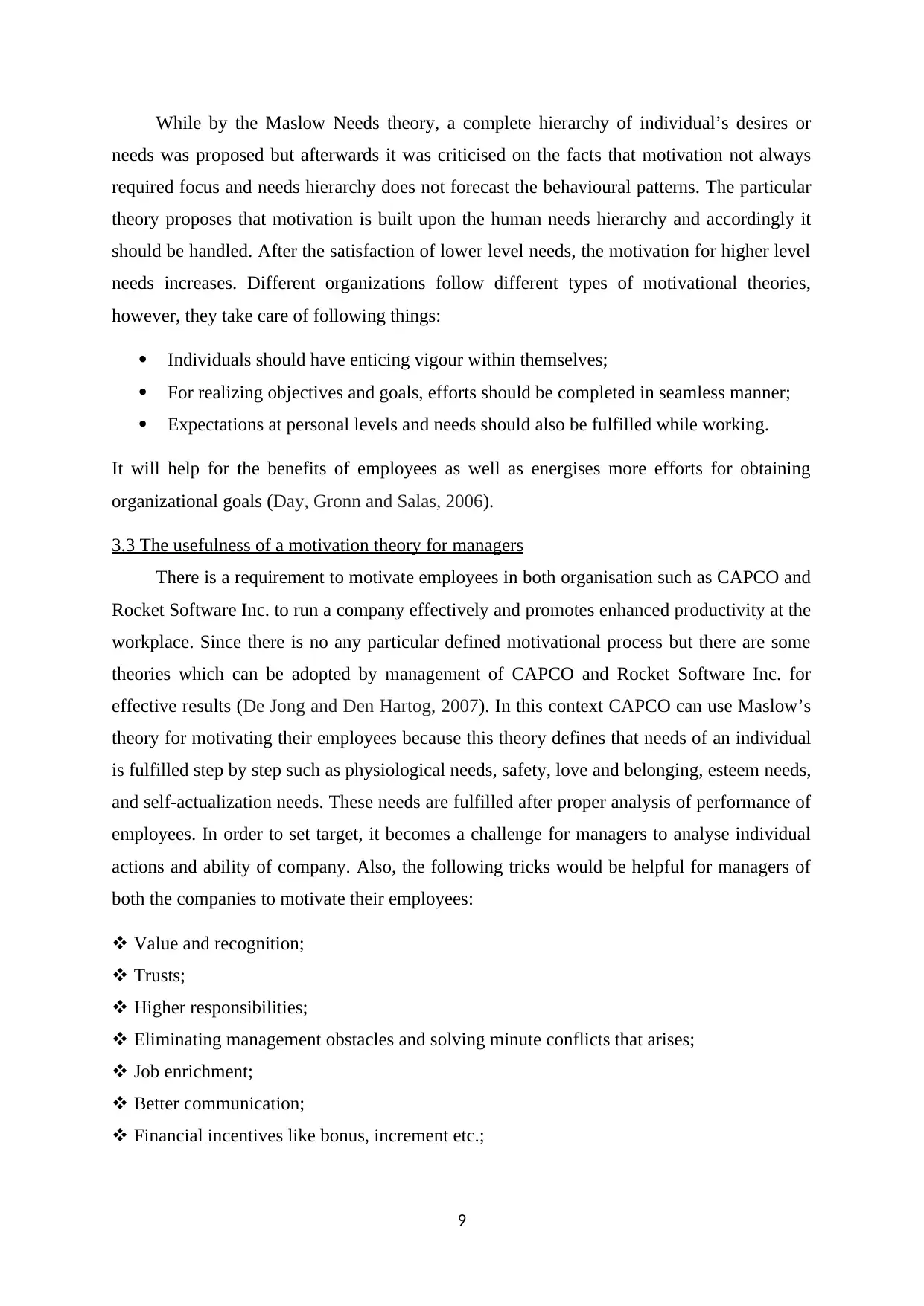
While by the Maslow Needs theory, a complete hierarchy of individual’s desires or
needs was proposed but afterwards it was criticised on the facts that motivation not always
required focus and needs hierarchy does not forecast the behavioural patterns. The particular
theory proposes that motivation is built upon the human needs hierarchy and accordingly it
should be handled. After the satisfaction of lower level needs, the motivation for higher level
needs increases. Different organizations follow different types of motivational theories,
however, they take care of following things:
Individuals should have enticing vigour within themselves;
For realizing objectives and goals, efforts should be completed in seamless manner;
Expectations at personal levels and needs should also be fulfilled while working.
It will help for the benefits of employees as well as energises more efforts for obtaining
organizational goals (Day, Gronn and Salas, 2006).
3.3 The usefulness of a motivation theory for managers
There is a requirement to motivate employees in both organisation such as CAPCO and
Rocket Software Inc. to run a company effectively and promotes enhanced productivity at the
workplace. Since there is no any particular defined motivational process but there are some
theories which can be adopted by management of CAPCO and Rocket Software Inc. for
effective results (De Jong and Den Hartog, 2007). In this context CAPCO can use Maslow’s
theory for motivating their employees because this theory defines that needs of an individual
is fulfilled step by step such as physiological needs, safety, love and belonging, esteem needs,
and self-actualization needs. These needs are fulfilled after proper analysis of performance of
employees. In order to set target, it becomes a challenge for managers to analyse individual
actions and ability of company. Also, the following tricks would be helpful for managers of
both the companies to motivate their employees:
Value and recognition;
Trusts;
Higher responsibilities;
Eliminating management obstacles and solving minute conflicts that arises;
Job enrichment;
Better communication;
Financial incentives like bonus, increment etc.;
9
needs was proposed but afterwards it was criticised on the facts that motivation not always
required focus and needs hierarchy does not forecast the behavioural patterns. The particular
theory proposes that motivation is built upon the human needs hierarchy and accordingly it
should be handled. After the satisfaction of lower level needs, the motivation for higher level
needs increases. Different organizations follow different types of motivational theories,
however, they take care of following things:
Individuals should have enticing vigour within themselves;
For realizing objectives and goals, efforts should be completed in seamless manner;
Expectations at personal levels and needs should also be fulfilled while working.
It will help for the benefits of employees as well as energises more efforts for obtaining
organizational goals (Day, Gronn and Salas, 2006).
3.3 The usefulness of a motivation theory for managers
There is a requirement to motivate employees in both organisation such as CAPCO and
Rocket Software Inc. to run a company effectively and promotes enhanced productivity at the
workplace. Since there is no any particular defined motivational process but there are some
theories which can be adopted by management of CAPCO and Rocket Software Inc. for
effective results (De Jong and Den Hartog, 2007). In this context CAPCO can use Maslow’s
theory for motivating their employees because this theory defines that needs of an individual
is fulfilled step by step such as physiological needs, safety, love and belonging, esteem needs,
and self-actualization needs. These needs are fulfilled after proper analysis of performance of
employees. In order to set target, it becomes a challenge for managers to analyse individual
actions and ability of company. Also, the following tricks would be helpful for managers of
both the companies to motivate their employees:
Value and recognition;
Trusts;
Higher responsibilities;
Eliminating management obstacles and solving minute conflicts that arises;
Job enrichment;
Better communication;
Financial incentives like bonus, increment etc.;
9
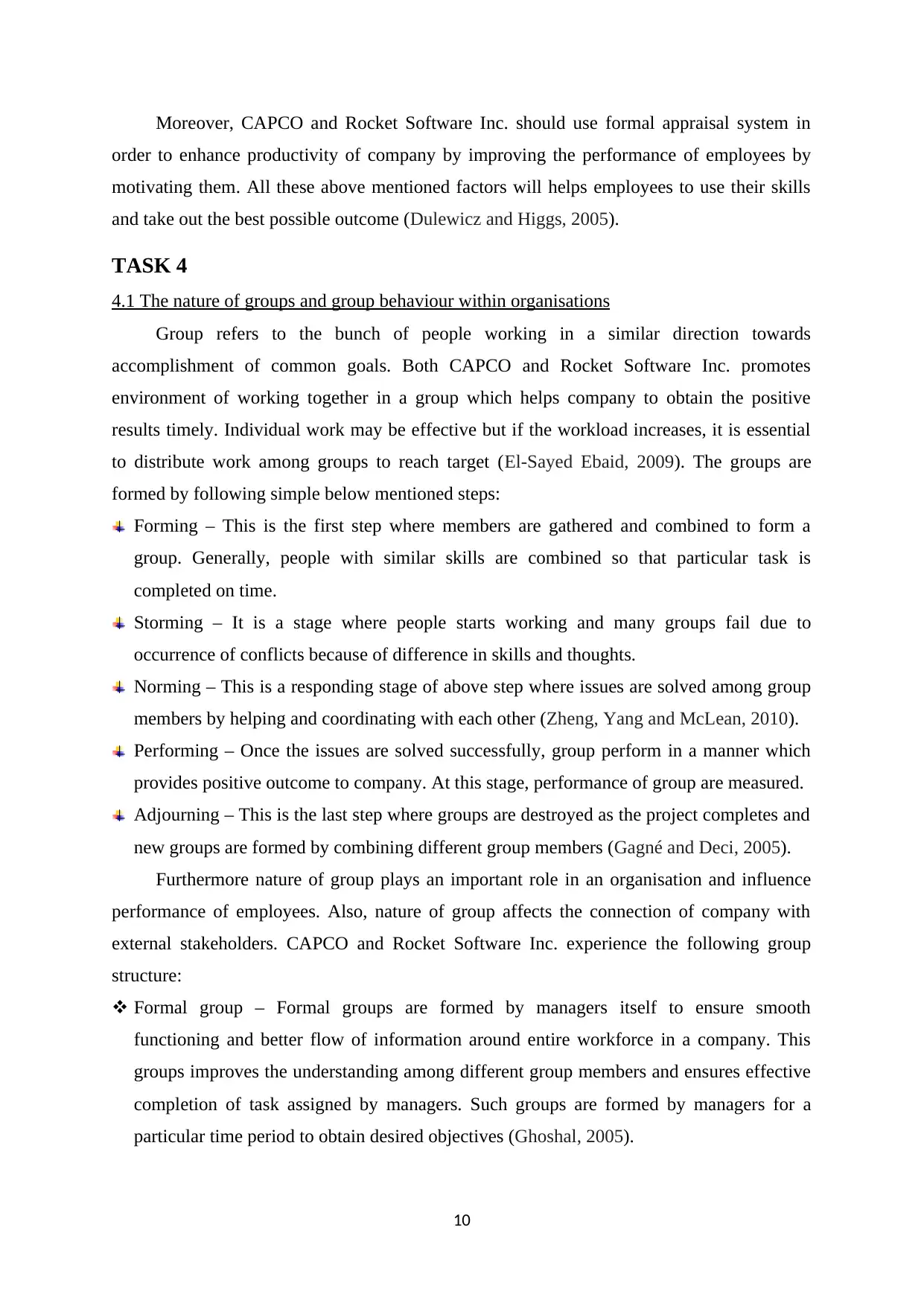
Moreover, CAPCO and Rocket Software Inc. should use formal appraisal system in
order to enhance productivity of company by improving the performance of employees by
motivating them. All these above mentioned factors will helps employees to use their skills
and take out the best possible outcome (Dulewicz and Higgs, 2005).
TASK 4
4.1 The nature of groups and group behaviour within organisations
Group refers to the bunch of people working in a similar direction towards
accomplishment of common goals. Both CAPCO and Rocket Software Inc. promotes
environment of working together in a group which helps company to obtain the positive
results timely. Individual work may be effective but if the workload increases, it is essential
to distribute work among groups to reach target (El-Sayed Ebaid, 2009). The groups are
formed by following simple below mentioned steps:
Forming – This is the first step where members are gathered and combined to form a
group. Generally, people with similar skills are combined so that particular task is
completed on time.
Storming – It is a stage where people starts working and many groups fail due to
occurrence of conflicts because of difference in skills and thoughts.
Norming – This is a responding stage of above step where issues are solved among group
members by helping and coordinating with each other (Zheng, Yang and McLean, 2010).
Performing – Once the issues are solved successfully, group perform in a manner which
provides positive outcome to company. At this stage, performance of group are measured.
Adjourning – This is the last step where groups are destroyed as the project completes and
new groups are formed by combining different group members (Gagné and Deci, 2005).
Furthermore nature of group plays an important role in an organisation and influence
performance of employees. Also, nature of group affects the connection of company with
external stakeholders. CAPCO and Rocket Software Inc. experience the following group
structure:
Formal group – Formal groups are formed by managers itself to ensure smooth
functioning and better flow of information around entire workforce in a company. This
groups improves the understanding among different group members and ensures effective
completion of task assigned by managers. Such groups are formed by managers for a
particular time period to obtain desired objectives (Ghoshal, 2005).
10
order to enhance productivity of company by improving the performance of employees by
motivating them. All these above mentioned factors will helps employees to use their skills
and take out the best possible outcome (Dulewicz and Higgs, 2005).
TASK 4
4.1 The nature of groups and group behaviour within organisations
Group refers to the bunch of people working in a similar direction towards
accomplishment of common goals. Both CAPCO and Rocket Software Inc. promotes
environment of working together in a group which helps company to obtain the positive
results timely. Individual work may be effective but if the workload increases, it is essential
to distribute work among groups to reach target (El-Sayed Ebaid, 2009). The groups are
formed by following simple below mentioned steps:
Forming – This is the first step where members are gathered and combined to form a
group. Generally, people with similar skills are combined so that particular task is
completed on time.
Storming – It is a stage where people starts working and many groups fail due to
occurrence of conflicts because of difference in skills and thoughts.
Norming – This is a responding stage of above step where issues are solved among group
members by helping and coordinating with each other (Zheng, Yang and McLean, 2010).
Performing – Once the issues are solved successfully, group perform in a manner which
provides positive outcome to company. At this stage, performance of group are measured.
Adjourning – This is the last step where groups are destroyed as the project completes and
new groups are formed by combining different group members (Gagné and Deci, 2005).
Furthermore nature of group plays an important role in an organisation and influence
performance of employees. Also, nature of group affects the connection of company with
external stakeholders. CAPCO and Rocket Software Inc. experience the following group
structure:
Formal group – Formal groups are formed by managers itself to ensure smooth
functioning and better flow of information around entire workforce in a company. This
groups improves the understanding among different group members and ensures effective
completion of task assigned by managers. Such groups are formed by managers for a
particular time period to obtain desired objectives (Ghoshal, 2005).
10
⊘ This is a preview!⊘
Do you want full access?
Subscribe today to unlock all pages.

Trusted by 1+ million students worldwide
1 out of 17
Related Documents
Your All-in-One AI-Powered Toolkit for Academic Success.
+13062052269
info@desklib.com
Available 24*7 on WhatsApp / Email
![[object Object]](/_next/static/media/star-bottom.7253800d.svg)
Unlock your academic potential
Copyright © 2020–2025 A2Z Services. All Rights Reserved. Developed and managed by ZUCOL.





